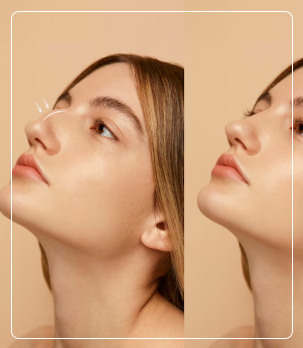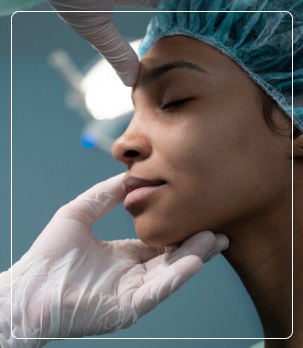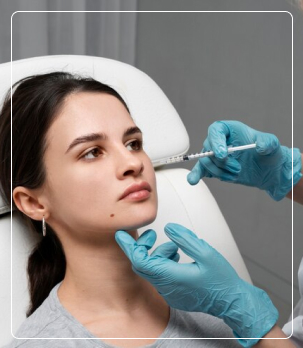Rhinoplasty
Plastic Surgeon in Kolkata
Non-Surgical Rhinoplasty Treatment In Kolkata
What is Non-Surgical Rhinoplasty?
Non-surgical rhinoplasty is a minimally invasive procedure that involves the use of dermal fillers to reshape and refine the nose. Unlike traditional surgical rhinoplasty, it does not require incisions or anaesthesia.
Diagnosis and Procedure of Non-Surgical Rhinoplasty
Diagnosis
The consultation process at our non-surgical rhinoplasty clinic in Kolkata usually involves:
Detailed medical history: This includes allergies, previous surgeries and any underlying medical conditions.
Facial assessment: Our doctor, Dr Anirban Ghosh, will evaluate the shape, size, and imperfections of your nose.
Desired outcome: Understanding your cosmetic goals is essential for designing the treatment plan.
While not mandatory, our non-surgical rhinoplasty doctor in Kolkata may recommend:
Photographs: Before and after photos can help track the treatment progress and check the results.
Allergy testing: This is particularly important if there is a history of allergies or concerns about potential reactions to the filler.


Procedure
Non-surgical rhinoplasty treatment involves the following steps.
Filler selection: The type of dermal filler used will depend on the required outcome and the patient’s individual needs. Common fillers include hyaluronic acid-based products.
Injection technique: The filler is injected using fine needles into specific areas of the nose to achieve the desired shape and contour. This may include the bridge, tip or nostrils.
Moulding: The doctor may gently massage the area to distribute the filler evenly and shape the nose.
When is Non-Surgical Rhinoplasty Recommended?
Non-surgical rhinoplasty is ideal for individuals seeking subtle improvements to their nasal profile.
It’s particularly well-suited for those with:
Desire for temporary results: If you are unsure about the long-term commitment of surgical rhinoplasty, a non-surgical option can help you determine the potential outcome.
Fear of surgery or anaesthesia: For those who are apprehensive about surgical procedures, non-surgical rhinoplasty offers a less invasive alternative.
Non-surgical nose job rhinoplasty is not a suitable option for:
Significant nasal deformities: Severe structural issues require surgical intervention.
Functional breathing problems: If you have difficulty breathing due to a deviated septum or other nasal obstructions, surgical rhinoplasty might be necessary.


How to Prepare for Non-Surgical Rhinoplasty?
Non-surgical rhinoplasty for a wide nose involves the following steps for preparation.
Consultation: Schedule a consultation with Dr Anirban Ghosh to discuss your expectations from the procedure.
Medical history: Provide a detailed medical history, including allergies and medications.
Avoid blood thinners: Stop taking blood thinners for a specified period before the procedure.
Additional Consideration: You can also enquire about any additional preparations that you need to make beforehand on the day of the procedure.
Benefits of Non-Surgical Rhinoplasty
Non-surgical rhinoplasty offers several advantages over traditional surgical rhinoplasty:
Minimal Downtime
Quick recovery: Patients can usually resume normal activities immediately after the procedure.
No postoperative discomfort: Swelling and bruising are minimal compared to surgical rhinoplasty.
Less Invasive
No surgery: The procedure involves no incisions or anaesthesia, reducing the risk of complications associated with surgery.
No scarring: As there are no incisions, there is no risk of visible scars.
Temporary effects: The results of non-surgical rhinoplasty are temporary, allowing for adjustments or complete reversal if desired.
Flexibility: Patients can experiment with different looks before committing to a permanent change.
Lower price point: Non-surgical rhinoplasty is generally less expensive than surgical rhinoplasty.

Recovery after Non-Surgical Rhinoplasty
One of the most significant advantages of non-surgical rhinoplasty is the minimal downtime required.
Unlike traditional surgical rhinoplasty, recovery is usually swift and uncomplicated.
Immediate Post-Procedure:
Swelling and bruising: Mild swelling and bruising are common immediately after the procedure. These symptoms usually subside within a few days.
Redness: The injection sites may appear red for a short period, but this fades quickly.
Tenderness: Some tenderness or discomfort may be experienced at the injection sites.
First Few Days:
Ice packs: Applying ice packs to the treated area can help reduce swelling and discomfort.
Avoid touching: It’s important to avoid touching the nose to prevent the filler from shifting.
Gentle cleansing: Use a gentle cleanser to clean the area around the nose, avoiding harsh products.
Over-the-counter pain relievers: If necessary, over-the-counter pain relievers can be taken to manage discomfort.
Important Considerations:
Avoid strenuous activity: While minimal downtime is required, it’s advisable to avoid strenuous physical activity for the first 24-48 hours.
Sun protection: Protecting the treated area from the sun is important to prevent discolouration.
Follow-up appointments: It’s essential to schedule follow-up appointments with our doctor to monitor the results and address any concerns.

